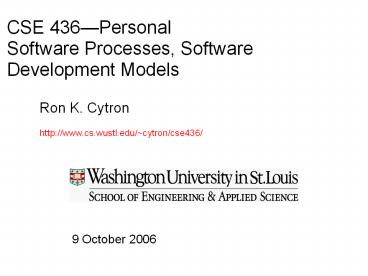Wash%20U%20DARPA%20PCES%20%20PI%20Meeting%20Report PowerPoint PPT Presentation
Title: Wash%20U%20DARPA%20PCES%20%20PI%20Meeting%20Report
1
CSE 436Personal Software Processes, Software
Development Models
Ron K. Cytron http//www.cs.wustl.edu/cytron/cse
436/
9 October 2006
2
Today
- Personal Software Processes
- Groups present requirements (postponed to next
week) - How did you elicit the requirements?
- How are the requirements structured?
- What interactions do you require with the
customer to firm up the requirements - Software development processes
- Break
- Groups discuss architecture
- Break down project into pieces
- Articulate integration and demonstration points
- Plan schedule
- Present architecture ideas to class
3
PSPPersonal Software Process
- What is this?
- Self-improvement process
- Managing time and other spare resources
- Becoming more effective, productive, valuable
- Increased awareness
- Productivity enhancement
- Feasibility
- Quality issues
- Why?
- How do you know where you are?
- How do you know where to go?
- How do you know how to get there?
4
Baseline Personal Process (PSP0)
- Planning
- Summary and overview
- Get or develop requirements
- Fill out plan summary
- Entry in time recording log
- Development
- Design the program
- Implement the design
- Compile, fix and log all defects
- Test, fix and log more defects
- Entry in time recording log
- Post Mortem
- Complete project plan summary
- Estimated and actual data
- Complete time and defect logs
- Today Planning
5
PSP0 Plan Summary
6
PSP0 Planning-Phase Script
- Requirements
- Elicit
- Elaborate
- Validate
- Resource estimation
- Best estimate
- Will serve as area of personal improvement
- Exit criteria
- Documentation
- Summary and Overview
- Requirements tabulated
- Estimated time for the project
- Entry in time log for this phase
7
Software Process Models
- Distinct set of activities, actions, tasks,
milestones, work products - Agreed upon by management and engineers
- Adds stability, control to an organization
- Steps vary by method
- Work products are code, documentation, data
- This is an area where WU students are deemed
deficient by interviewers. - Take note
- Waterfall
- Spiral
- XP (Extreme Programming)
8
Waterfall Model
- Also called classic life cycle, proposed by
Winston Royce in 1970 - Original proposal allowed for feedback and loops
- In practice, strictly linear
- Called a prescriptive process model
9
Waterfall Model
- Communication
- Initiation, requirements gathering
- Planning
- Estimating, scheduling, tracking mechanisms
- Modeling
- Analysis and design
- Construction
- Code and test
- Deployment
- Delivery, support, feedback
10
Waterfall Model
- Real projects find it difficult to be so linear
- Customers have trouble stating requirements
consistently, accurately, minimally. - Model does not account for uncertainty
- Working version of program not realized until end
of model - Tracking functional and nonfunctional properties
is hard - Customer confidence can become weak
- Model may work in the small but fails in the
large
11
Incremental Models
- All perform some kind of iteration over waterfall
model - Waterfall becomes a pipeline, with next iteration
starting when requirements change or become more
clear
functionality
- Communication
- Planning
- Design/Modeling
- Construction
- Deployment
time
12
RADRapid Application Deployment
- Breaks problem into pieces
- Utilizes concurrent design and construction
- Huge integration exercise at the end
- Alleged 60-90 day time span
Communication
Planning
Deployment
13
RAD drawbacks
- Requires sufficient human resources
- Must commit to rapid development process
- Vision of design must remain consistent among
teams - Tends to fade or become chaotic over time
- Requires a project that can be componentized
- Levels of abstraction and insulation between
teams can cause performance issues - Use of cutting-edge technology in one team can
sink the whole project if it fails
14
Evolutionary Models
- Examples
- Prototyping
- Spiral
- Concurrent Development
- Iterative approaches
- Increasingly more complete versions of the
product are generated - Articulated deliveries can help planning
- Revising design delivers a more on-target product
- Revisiting implementation can remedy a bad
initial approach - Must avoid urge to begin over completely
15
Prototyping Model
Communication
Quick plan
Quick design
Deployment, delivery, feedback
Construction of prototype
16
Prototyping Model
- Useful when
- Insufficient requirements exist at start
- Behavior of some components unknown
- New or strange OS
- Hardware in progress
- HCI (Human-Computer Interface) factors not yet
firm - Algorithmic uncertainties speed, space
- However
- Testing may be minimal
- Not intended for ultimate delivery of longevity
- Little or no documentation is produced
- Customer and team must agree on this approach
up-front - Expectations should not be overly high on either
side
17
Schedule
- No group meetings this (Oct 13) or next Friday
(Oct 20,fall break) - In class 16 October, prepare to present
requirements and refined architecture
decomposition

